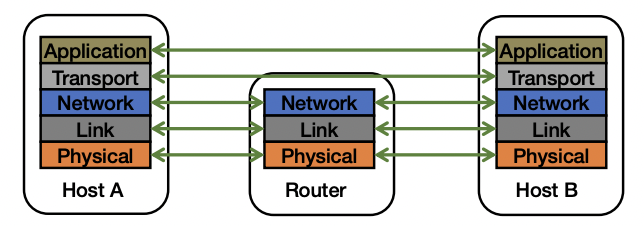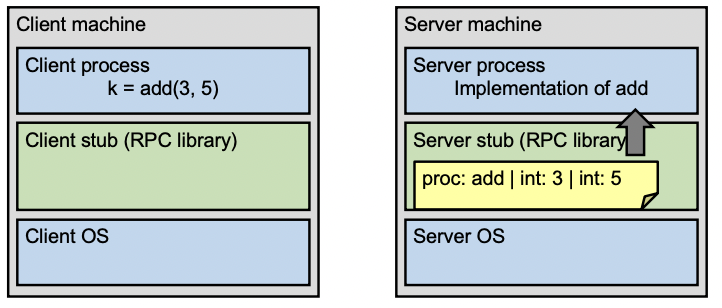June 20, 2022
Distributed Systems System Design Interview
The problem of communication
- A process on Host A wants to talk to the process on Host B
- A and B must agree on the meaning of the bits being sent and received at many different levels, including:
- How many volts is a 0 bit, a 1 bit?
- How does the receiver know which is the last bit?
- How many bits long is a number?

- Re-implement every application for every new underlying transmission medium?
- Change every application on any change to an underlying transmission medium?
- No! But how does the Internet design avoid this?
Solution: Layering

- Intermediate layers provide a set of abstractions for applications and media
- New apps or media need only implement for the intermediate layer’s interface
Layering in the Internet

- Transport: Provide end-to-end communication between processes on different hosts
- Network: Deliver packets to destinations on other (heterogeneous) networks
- Link: Enables end hosts to exchange atomic messages with each other
- Physical: Moves bits between two hosts connected by a physical link
Logical communication between layers
- How to forge an agreement on the meaning of bits exchanged b/w two hosts?
- Protocol: Rules that govern the format, contents, and meaning of messages
- Each layer on a host interacts with its peer host’s corresponding layer via the protocol interface

Physical communication
- Communication goes down to the physical network
- Then from network peer to peer
- Then up to the relevant application

Communication between peers
- How do peer protocols coordinate with each other?
- The layer attaches its own header (H) to communicate with peer
- Higher layers’ headers, data encapsulated inside the message
- Lower layers don’t generally inspect higher layers’ headers

Network socket-based communication
- Socket: The interface the OS provides to the network
- Provides inter-process explicit message exchange
- Can build distributed systems atop sockets: send(), recv()
- e.g.: put(key,value) -> message

Socket programming: still not great
// Create a socket for the client
if ((sockfd = socket (AF_INET, SOCK_STREAM, 0)) < 0) {
perror(”Socket creation");
exit(2);
}
// Set server address and port
memset(&servaddr, 0, sizeof(servaddr));
servaddr.sin_family = AF_INET;
servaddr.sin_addr.s_addr = inet_addr(argv[1]);
servaddr.sin_port = htons(SERV_PORT); // to big-endian
// Establish TCP connection
if (connect(sockfd, (struct sockaddr *) &servaddr, sizeof(servaddr)) < 0) {
perror(”Connect to server");
exit(3);
}
// Transmit the data over the TCP connection
send(sockfd, buf, strlen(buf), 0);- Lots for the programmer to deal with every time
- How to separate different requests on the same connection?
- How to write bytes to the network/read bytes from the network?
- What if Host A’s process is written in Go and Host B’s process is in C++?
- What to do with those bytes?
- Still pretty painful… have to worry a lot about the network

Why RPC?
- The typical programmer is trained to write single-threaded code that runs in one place
- Goal: Easy-to-program network communication that makes client-server communication seem transparent
- Retains the “feel” of writing centralized code
- Programmers needn’t think (much) about the network
Everyone uses RPCs
- Google gRPC
- Facebook/Apache Thrift
- Twitter Finagle
- …
What’s the goal of RPC?
- Within a single program, running in a single process, recall the well-known notion of a procedure call:
- Caller pushes arguments onto the stack,
- jumps to address of callee function
- Callee reads arguments from the stack,
- executes, puts return value in a register,
- returns to the next instruction in the caller
- Caller pushes arguments onto the stack,
RPC’s Goal: make communication appear like a local procedure call: way less painful than sockets
RPC issues
- Heterogeneity
- The client needs to rendezvous with the server
- The server must dispatch to the required function
- What if the server is a different type of machine?
- Failure
- What if messages get dropped?
- What if the client, server, or network fails?
- Performance
- Procedure call takes ≈ 10 cycles ≈ 3 ns
- RPC in a data center takes ≈ 10 μs (10^3 slower)
- In the wide area, typically 10^6 slower
Problem: Differences in data representation
- Not an issue for local procedure calls
- For a remote procedure call, a remote machine may:
- Run process written in a different language
- Represent data types using different sizes
- Use a different byte ordering (endianness)
- Represent floating point numbers differently
- Have different data alignment requirements
- e.g., 4-byte type begins only on a 4-byte memory boundary
Solution: Interface Description Language
- Mechanism to pass procedure parameters and return values in a machine-independent way
- Programmer may write an interface description in the IDL
- Defines API for procedure calls: names, parameter/return types
- Then runs an IDL compiler which generates:
- Code to marshal (convert) native data types into machine-independent byte streams (and vice-versa, called unmarshaling)
- Client stub: Forwards local procedure call as a request to server
- Server stub: Dispatches RPC to its implementation
A day in the life of an RPC
- Client calls stub function (pushes parameters onto the stack)

- Stub marshals parameters to a network message

- OS sends a network message to the server

- Server OS receives the message, sends it up to stub

- Server stub unmarshals params, calls server function

- The server function runs, returns a value

- Server stub marshals the return value, sends message

- Server OS sends the reply back across the network

- Client OS receives the reply and passes it up to stub

- Client stub unmarshals return value, returns to the client

What could possibly go wrong?
- All of these may look the same to the client
- The client may crash and reboot
- Packets may be dropped
- Some individual packet loss on the Internet
- Broken routing results in many lost packets
- The server may crash and reboot
- The network or server might just be very slow
Summary
- Layers are our friends!
- RPCs are everywhere
- Necessary issues surrounding machine heterogeneity
- Subtle issues around failures

